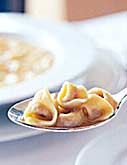 Merló is a splendid place for navel grazing. Along with Parmigiano-Reggiano, prosciutto di Parma, and balsamic vinegar, tortellini, those little filled pasta nuggets, are a crown jewel of Emilia-Romagna cuisine.
Merló is a splendid place for navel grazing. Along with Parmigiano-Reggiano, prosciutto di Parma, and balsamic vinegar, tortellini, those little filled pasta nuggets, are a crown jewel of Emilia-Romagna cuisine.
At Merló the handmade tortellini and tortelloni (same thing, larger scale) are divine, delicate packets filled with varying cheeses and meats. Among the five kinds on the menu, tortellini in brodo (here a pure greaseless hen broth) is austere and irresistible, while tortelloni with porcini mushroom sauce is rich and earthy. Tagliatelle bolognese, another specialty from this region, saturates the taste buds with its creamy, long-simmered meat and vegetable sauce. The same premier ragù gets layered into the delightful spinach-pasta lasagne. The most adventurous of the 15 pastas is green tagliolini (ribbons thinner than tagliatelle) tossed with Sardinian bottarga (pressed dried mullet roe). It tastes provocatively briny, and the added kick of red chilies makes this an intense experience. Even the breadbasket includes rusticated crackers made with pasta dough.
But there’s more to Merló than noodles. For appetizers, it’s hard to beat the prosciutto di Parma served with sliced pear, chunks of Parmesan, and huge breadsticks. Up there as well are the raw artichoke salad and the dense pistachio-studded terrine of prosciutto, veal, and pork tenderloin with peppery balsamic-marinated cantaloupe slices. And two entrées deserve special mention: the pan-seared walleye pike alongside baby spinach salad with apples and pine nuts dressed in cherry vinegar and olive oil, and the thinly sliced strip steak served room temperature under an arugula blanket with balsamic vinegar and grated Parmesan. The wine list needs improvement; still, I spotted a supple and fruity 2000 Dolcetto d’Alba Sandrone that nicely navigated these courses.
Giampaolo Sassi and his wife, Luisa Silvia Marani (also chef), and their son Stefano co-owned a restaurant in Bologna until they moved to Chicago last year and opened Merló. Making it real is all they know, respecting prime ingredients in the Italian tradition by presenting them with a minimum of clutter. The understated setting is true to the spirit-Italian furniture, soothing sponged peach walls, and low-key yet well-trained service. During our last meal here, we reminisced about the Italian countryside as we lingered over a bracing budino bianco (citrus custard pudding), good espresso, and a cold limoncello liqueur-a serious citrus jolt for the road home.
* * *
Shortly after my menu at Gioco caught on fire, I realized that the new chef, Corcoran O’Connor, had reignited the kitchen. Our waiter nonchalantly moved the candle back, put out the oversize menu-“It happens all the time”-and brought a delicious, puffy microcrust pizza paved with prosciutto shreds from the woodburning oven. Those five years O’Connor spent as sous-chef at Spiaggia must have been valuable-he’s made this alluring South Loop haven a destination once again.
Gioco’s handsome bar still bustles with a fancy martini- and Negroni-thirsty crowd that gets younger as the night gets older, but I am content with the supply of Red Hen Bakery country loaves brought with spicy marinated olives to start the meal. You can tell that co-owner Jerry Kleiner is a designer to the core: He has filled the wine rack partitions dividing the bilevel space with over-the-hill Italian wines bought in bulk like useless books chosen for their old bindings.
O’Connor’s Tuscan and Umbrian fare is equally simple and sophisticated: Seared sea scallops get new bounce from crispy fried artichokes and accents of sage and mint; and hearts of palm salad with shaved radicchio and celery is stylishly enriched with Gorgonzola. But rabbit confit with fava bean purée is 100 percent country. O’Connor likes octopus, regularly as a bright carpaccio with fresh oregano and black olives, and frequently as a special, grilled with arugula, celery, and olives in lemon vinaigrette. And he’s so into beef carpaccio that he presents it two ways: with spicy aïoli and capers, and in a lighter rendering with arugula and Parmesan.
Pastas are a high point here, too. Tuscan-style tortelloni filled with ricotta and spinach come cloaked in butter, sage, and pecorino. Excellent eggplant ravioli are first glazed in butter, then drizzled with fine pesto-flecked olive oil-a pasta so refined, Spiaggia might kill for it. Gioco serves a deeply savory Tuscan counterpart to tagliatelle alla bolognese, handmade spaghetti tossed in a muscular ragù packed with a farm full of meats: ground beef, veal, pork, pancetta, chicken, and chicken livers. From a well-organized list, a cherry-and-spice-flavored 1999 California Renwood Nebbiolo Amador County has all the right stuff for Italian cuisine.
Meat, especially beef, is also a strength of the entrée selection, which leads off with a 40-ounce porterhouse Florentine for two. I also enjoyed the wood-grilled beef filet with luxurious Barolo sauce. Among fish, roasted halibut with mushrooms and cipolline (small sweet onions) is a delight. The whole seared Mediterranean bass is enjoyable if not much different from what you’d find at a good Greek restaurant, except for the pairing with first-rate sautéed ra-pini dotted with cubed potatoes. The first time I tried the bass, I let the waiter bone it. Bad move. He botched the job so profoundly, the next time I opted to handle it myself. I had no problem lifting the tasty meat and crisp skin off the bone.
Crema gratinate, a hefty cousin to crème brûlée, is vibrant with lemon and orange zest, while the frozen cassata is a variation on a semifreddo made with meringue and ricotta. Chock-a-block with pine nuts, dried figs, and almonds, it’s much better than the frozen fruitcake it resembles. If only the feeble espresso had been as brawny as the rest of the meal. Despite that weak ending, the food at each of these restaurants can provide a Proustian reverie, Italian style.



